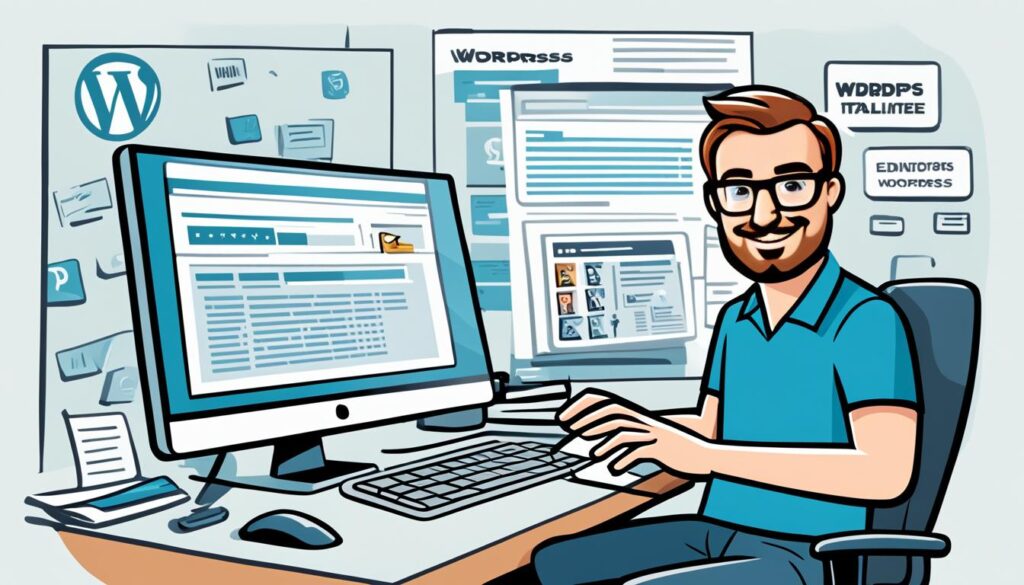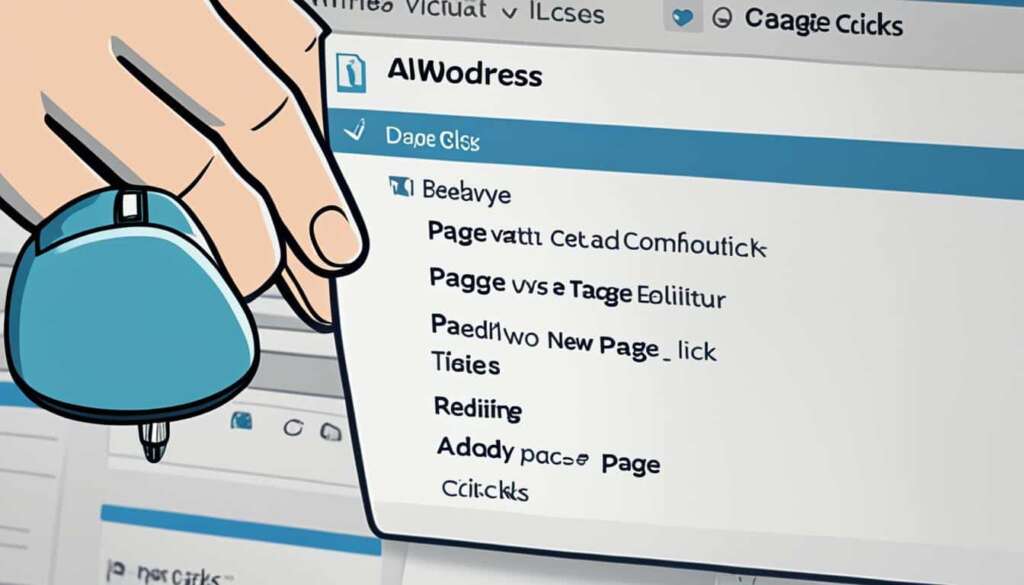Table of Contents
In this guide, we will provide you with a step-by-step approach to editing pages in WordPress. Whether you’re a beginner or have some experience with WordPress, this guide will help you streamline your website updates and make editing pages a breeze.
Key Takeaways:
- Learn how to navigate the WordPress dashboard and familiarize yourself with its main components.
- Access the page editor in WordPress to begin making changes to your pages.
- Explore the various editing options available, from formatting text to adding media.
- Understand how to use WordPress blocks to create engaging page layouts.
- Save, publish, and update your pages correctly to make your edits visible to visitors.
Understanding the WordPress Dashboard
Before we dive into editing pages, it’s essential to familiarize yourself with the WordPress dashboard. The dashboard is your command center, where you can manage all aspects of your website. It provides an intuitive interface that allows you to easily navigate through different sections and perform various tasks.
Let’s take a closer look at the main components of the WordPress dashboard:
- Navigation Menu: Located on the left-hand side, the navigation menu provides quick access to different sections of the dashboard. Here, you’ll find options to manage your pages, posts, media library, themes, and plugins.
- Posts: This section allows you to create, edit, and manage your blog posts. You can write new posts, categorize them, and even schedule them for future publication.
- Media Library: The media library is where you can upload and manage all your media files, such as images, videos, and audio. It provides a central hub for organizing and inserting media into your pages and posts.
- Pages: In the pages section, you can create, edit, and manage the static pages of your website. Pages are different from blog posts as they don’t have a specific publishing date and are typically used for timeless content like your About or Contact pages.
- Appearance: This section is where you can customize the look and feel of your website. You can choose from different themes, customize the layout, and even add widgets to your sidebar or footer.
- Plugins: Plugins are like mini-apps that enhance and extend the functionality of your WordPress website. In the plugins section, you can browse and install new plugins, as well as deactivate or delete ones you no longer need.
The WordPress dashboard provides a user-friendly interface that simplifies website management. Take some time to explore each section and familiarize yourself with its functionalities. You’ll soon discover how effortless it is to navigate and make necessary updates to your website.
Now that you have a solid foundation of the WordPress dashboard, you’re ready to move on to the next section and learn how to access the page editor.
Accessing the Page Editor
Once you’re comfortable navigating the WordPress dashboard, it’s time to dive into the page editor. Here’s a step-by-step guide to help you access the WordPress page editor:
- Log in to your WordPress admin dashboard.
- In the left-hand navigation menu, locate the “Pages” section and click on it.
- You will see a list of all the pages on your WordPress website. Find the specific page you want to edit and click on its title.
- The page editor will now open, displaying the content and settings for that particular page.
By following these simple steps, you’ll be able to access the WordPress page editor and start making changes to your website’s pages.
It’s important to note that the page editor interface may vary depending on the version of WordPress you’re using or any customizations you have made to your website. However, the basic steps mentioned above should apply to most WordPress installations.
Pro Tip: Remember to save your changes regularly while editing the page to avoid losing any modifications you’ve made.
Now that you’ve accessed the page editor, it’s time to explore the various editing options available to customize your page content. We’ll cover these options in detail in the next section. But first, let’s take a visual break and have a look at an image that represents the power of WordPress page editing.

Now that you’ve got a glimpse of the WordPress page editor, let’s delve into the exciting world of editing options that await you!
Exploring the Page Editing Options
Once you’ve opened the page editor in WordPress, you gain access to a range of powerful editing options that allow you to customize your page content to perfection. Whether you’re adding and formatting text, inserting images and videos, or enhancing the overall aesthetics of your page, WordPress provides a user-friendly interface to make editing a breeze.
Text Formatting
With WordPress, you have complete control over the appearance of your text. Use the following options to enhance your content:
- Bold: Emphasize important words or phrases by making them bold.
- Italic: Add emphasis or provide additional context by italicizing specific text.
- Underline: Highlight key points by underlining important information.
- Strikethrough: Apply a strikethrough format to indicate deleted or revised text.
Inserting Media
WordPress enables you to enrich your page with visual and multimedia elements. Consider the following options:
- Images: Enhance the visual appeal of your page by inserting relevant images. Ensure the alt text describes the image for better accessibility and SEO.
- Videos: Embed videos from platforms like YouTube or Vimeo to engage your audience visually.
Creating Links
WordPress makes it easy to add links to your page content. Whether you’re referencing external sources or internal pages on your website, the link editing options provide a seamless way to connect information.
“The ability to add links to my page content has improved the user experience on my website tremendously. It allows me to direct my audience to relevant resources, increasing overall engagement.” – Sarah, a WordPress user
Using Widgets and Shortcodes
Widgets and shortcodes extend your page’s functionality by adding dynamic elements and features. They allow you to embed forms, social media feeds, calendars, and more, without any coding knowledge.
Take a look at the WordPress editor interface, showcasing the various editing options:
As you explore the page editing options in WordPress, feel free to experiment with different combinations to achieve the desired visual and functional effects. Remember, the goal is to create compelling and engaging pages that resonate with your audience.
Mastering Page Layout with Blocks
Designing the layout of your WordPress pages has never been easier with the help of WordPress blocks. These versatile content elements allow you to create visually appealing and engaging pages effortlessly. In this section, we will guide you through the process of adding and arranging blocks, giving you the flexibility to customize your page layout to perfection.
When you navigate to the page editor in WordPress, you will find a wide range of block options at your disposal. Each block serves a specific purpose, from adding text and images to embedding videos and showcasing galleries. By combining and arranging blocks, you can create dynamic and interactive content that captivates your audience. Let’s explore some of the block categories and their functions:
- Text: Add headings, paragraphs, lists, and more to structure your written content.
- Media: Insert images, videos, and audio files to enhance your page visually and audibly.
- Layout: Arrange your page elements with options like columns, buttons, and separators.
- Embeds: Easily integrate external content from platforms like YouTube, Twitter, and Instagram.
To add a block to your page, simply click the “+” icon within the editor and choose the desired block from the available options. Once added, you can easily rearrange the blocks by dragging and dropping them to your preferred position. This intuitive interface allows you to experiment with different layouts and visual arrangements until you achieve the desired result.
In addition to the standard blocks provided by WordPress, you can also explore and install various block plugins to expand your design possibilities. These plugins offer specialized blocks for specific functionality, such as contact forms, testimonials, galleries, and more.
Now, let’s take a closer look at an example of how blocks can be used to create an appealing page layout:
| Block Type | Function |
|---|---|
| Heading Block | Introduce the page topic and grab the reader’s attention. |
| Image Block | Highlight a visually striking image related to the content. |
| Text Block | Provide informative text to elaborate on the page topic. |
| Quote Block | Include a relevant quote or testimonial to add credibility. |
| Video Block | Embed a video tutorial or demonstration to enhance engagement. |
| Call-to-Action Block | Prompt readers to take action with a compelling message and button. |
By strategically combining these blocks, you can create a visually appealing and informative page layout that guides your audience through the content and encourages further interaction.
With the power of WordPress blocks, you have the creative freedom to design stunning page layouts that effectively convey your message. Experiment with different combinations, explore block plugins, and let your imagination run wild.
Saving, Publishing, and Updating Pages
Once you’ve made your changes, it’s crucial to save, publish, or update your pages correctly. This ensures that your website visitors can see the latest content updates or that your changes are securely saved for future updates.
Saving Pages
When you’re in the WordPress page editor, saving your work is simple. Just click on the “Save” button located at the top right corner of the screen. This action will save your changes and update the page with the new content.
Publishing Pages
If you’re ready to make your changes live and visible to your audience, you can publish your page. To do this, click on the “Publish” button. WordPress will update the page and make it accessible to everyone who visits your website.
Updating Pages
If you’ve previously published a page and need to make additional edits or updates, you can easily update the existing content. Open the page in the editor and make the necessary changes. Once you’re satisfied, click on the “Update” button to apply the modifications. This action will overwrite the previous version of the page with the newly updated one.
By following these steps, you can confidently save, publish, and update your pages in WordPress, ensuring that your website always reflects the most up-to-date information.
| Action | Description |
|---|---|
| Save | Saves your changes and updates the page with new content |
| Publish | Makes your changes live and visible to website visitors |
| Update | Applies edits or updates to a previously published page |
Conclusion
Now that you’ve completed our step-by-step guide, you have acquired the knowledge and tools necessary to edit pages smoothly in WordPress. Whether you’re a beginner or have some experience with WordPress, this guide has provided you with valuable insights and techniques to streamline your website updates.
Remember that practice makes perfect, so don’t hesitate to refer back to this guide whenever you need a refresher or encounter new editing challenges. WordPress offers incredible power and flexibility in creating a compelling website experience for your audience.
By familiarizing yourself with the WordPress dashboard, accessing the page editor, exploring the various editing options, mastering page layout with blocks, and saving, publishing, and updating your pages, you are now equipped to take full control of your website’s content and design.
Embrace the endless possibilities that WordPress has to offer, and enjoy creating engaging and visually stunning pages that leave a lasting impression on your visitors. Happy editing!
FAQ
How do I edit a page in WordPress?
To edit a page in WordPress, follow these steps:
1. Log in to your WordPress dashboard.
2. Navigate to the “Pages” section.
3. Locate the specific page you want to edit.
4. Click on the page title to open the editor.
5. Make the desired changes to the page content.
6. When you’re done editing, click the “Update” button to save the changes and make them live on your website.
What is the WordPress dashboard?
The WordPress dashboard is the admin area where you manage your website’s content, settings, and design. It provides a user-friendly interface that allows you to control all aspects of your WordPress site, including creating and editing pages, managing media files, and customizing the site’s appearance.
How do I access the page editor in WordPress?
To access the page editor in WordPress, follow these steps:
1. Log in to your WordPress dashboard.
2. From the left-hand menu, click on “Pages.”
3. Choose the specific page you want to edit by clicking on its title.
4. The page editor will open, allowing you to make changes to the content and layout of the page.
What editing options are available in the WordPress page editor?
The WordPress page editor offers a wide range of editing options, including:
– Adding and formatting text
– Inserting images and videos
– Creating hyperlinks
– Adjusting text alignments
– Applying custom styles and fonts
– Embedding media content
– Using pre-designed page templates
These options give you the flexibility to customize your page content according to your preferences and needs.
How can I create a specific page layout in WordPress?
In WordPress, you can easily create specific page layouts using blocks. Blocks are individual units of content that you can add, rearrange, and customize within the page editor. By leveraging blocks, you can design visually appealing and engaging pages, arranging elements such as text, images, headings, and more in a flexible and intuitive way.
How do I save, publish, or update pages in WordPress?
To save, publish, or update pages in WordPress, follow these steps:
1. After making the desired changes to a page, click the “Save Draft” button to save your changes as a draft without making them live.
2. If you want to make the changes live, click the “Publish” button to publish the updated page immediately.
3. If you have previously published the page and want to update it, click the “Update” button. This will apply your changes and update the existing published version of the page.












